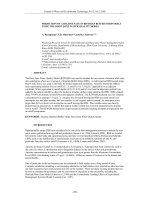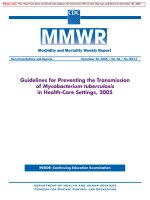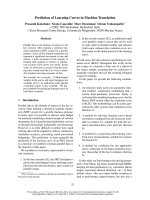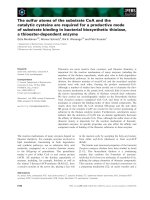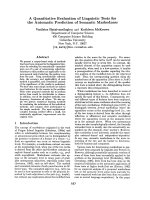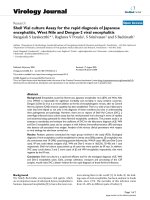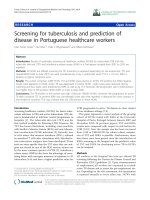Integrating DNA sequence features for more accurate prediction of replication origins in some double stranded DNA viral genomes
Bạn đang xem bản rút gọn của tài liệu. Xem và tải ngay bản đầy đủ của tài liệu tại đây (1.56 MB, 144 trang )
INTEGRATING DNA SEQUENCE FEATURES FOR MORE
ACCURATE PREDICTION OF REPLICATION ORIGINS IN
SOME DOUBLE–STRANDED DNA VIRAL GENOMES
ZHAO WANTING
(Master of Science, Northeast Normal University, China )
A THESIS SUBMITTED
FOR THE DEGREE OF DOCTOR OF PHILOSOPHY
DEPARTMENT OF STATISTICS AND APPLIED PROBABILITY
NATIONAL UNIVERSITY OF SINGAPORE
2010
i
Acknowledgements
This thesis would not have been possible without the support and help of many
people. It is my pleasure to express my gratitude to all of them.
I would like to thank my supervisors, Associate Professor Choi Kwok Pui
and Dr. Li Jialiang, whose invaluable advice and guidance, endless patience and
encouragement have been crucial to the completion of this thesis. During the past
four years, I have been fortunate to receive their continuous support and to learn
a lot from them, not only on the way to do research, but also the careful and
precise manner to conduct scientific research. I truly appreciate all the time and
effort they have spent in helping me to solve the problems encountered.
I would like to express my sincere gratitude and appreciation to Professor Bai
Zhidong and Professor Chen Zehua for his continuous encouragement and support.
My gratitude also goes to the National University of Singapore for awarding me
a research scholarship, and the Department of Statistics and Applied Probability
for providing an excellent research environment. During my Ph.D. programme
ii
I received continuous help from staff in our department, especially our helpful
IT support personnel Ms. Yvonne Chow and Mr. Zhang Rong for advice and
assistance in computing.
I warmly thank Dr. Chew Soon Huat, David for his valuable advice and
friendly help. His extensive discussions around my work have been very helpful
for this study.
It is a great pleasure to thank my friendly colleagues Mr. Loke Chok Kang
for much help learning computer software, and Dr. Wang Xiaoying and Dr. Zhao
Jingyuan for useful discussion during my study. I also would like to thank my
friends: Dr. Zhang Rongli, Mr. Wang Xiping, Ms. Li Hua, who have given me
much help in my study and life. Sincere thanks to all my friends who helped me
in one way or another.
Finally, I am greatly indebted to my parents, who have never failed to encourage me and to support me whenever they could. I feel a deep sense of gratitude
for my husband Yu Dingyi, for his love, thoughtfulness and cheering me on.
CONTENTS
iii
Contents
Acknowledgements
Summary
List of Tables
List of Figures
1 Introduction
i
viii
xi
xiii
1
1.1
Biological Background . . . . . . . . . . . . . . . . . . . . . . . . .
3
1.2
Herpesviruses . . . . . . . . . . . . . . . . . . . . . . . . . . . . . .
5
1.3
Replication Origins . . . . . . . . . . . . . . . . . . . . . . . . . . .
8
1.4
Organization of the Thesis . . . . . . . . . . . . . . . . . . . . . . .
8
CONTENTS
iv
2 Literature Review
11
2.1
Experimental Approaches to Identify Replication Origins . . . . . . 11
2.2
Computational Approaches to Predict Replication Origins . . . . . 13
2.2.1
Prediction of Replication Origins in Bacterial, Archaeal and
Eukaryotic Genomes . . . . . . . . . . . . . . . . . . . . . . 13
2.2.2
Prediction of Replication Origins in Viruses . . . . . . . . . 18
3 Methodology
3.1
25
Converting Sequence Features into Numerical Data . . . . . . . . . 27
3.1.1
Data Set to Be Analyzed . . . . . . . . . . . . . . . . . . . . 27
3.1.2
Converting Palindromes to Numerical Data
3.1.3
Converting Close Direct Repeats to Numerical Data . . . . . 31
3.1.4
Converting AT Content to Numerical Data . . . . . . . . . . 32
3.1.5
Computing the Window Scores . . . . . . . . . . . . . . . . 32
3.1.6
Local Maxima . . . . . . . . . . . . . . . . . . . . . . . . . . 33
. . . . . . . . . 30
3.2
Comparison of Approaches Based on Single Sequence Feature
. . . 35
3.3
Pre-processing of Data Set . . . . . . . . . . . . . . . . . . . . . . . 37
CONTENTS
v
3.4
Generalized Additive Models . . . . . . . . . . . . . . . . . . . . . . 44
3.5
Software for Implementing Generalized Additive Models
3.6
ROC and AUC . . . . . . . . . . . . . . . . . . . . . . . . . . . . . 47
. . . . . . 46
3.6.1
3.6.2
3.7
The Receiver Operating Characteristic (ROC) Curve . . . . 47
The Area Under the ROC Curve (AUC) . . . . . . . . . . . 51
Further Refinement of the GAM Approach . . . . . . . . . . . . . . 57
3.7.1
3.7.2
3.8
Features to Be Selected . . . . . . . . . . . . . . . . . . . . . 58
Model Selection . . . . . . . . . . . . . . . . . . . . . . . . . 62
The Application of Generalized Additive Models to Prediction of
Replication Origins in Caudoviruses . . . . . . . . . . . . . . . . . . 64
4 Results and Discussion
4.1
68
Predictive Accuracies using Palindromes, AT content, Repeats and
Their Local Maxima . . . . . . . . . . . . . . . . . . . . . . . . . . 69
4.2
Predictive Accuracy for Known Replication Origins in Herpesviruses 77
4.3
Prediction of Unknown Replication Origins in Herpesviruses . . . . 84
4.4
Refined GAM Approach and Results . . . . . . . . . . . . . . . . . 91
CONTENTS
vi
4.5
Comparing the Predictive Accuracy with Existing Methods . . . . . 92
4.6
Applying the GAM Approach to Caudoviruses . . . . . . . . . . . . 96
4.7
Discussion . . . . . . . . . . . . . . . . . . . . . . . . . . . . . . . . 101
4.7.1
GLM Approach . . . . . . . . . . . . . . . . . . . . . . . . . 101
4.7.2
Boosting Approach . . . . . . . . . . . . . . . . . . . . . . . 102
4.7.3
Predictive Accuracy for α-Herpesvriuses . . . . . . . . . . . 102
4.7.4
Stepwise GAM Approach by the AIC Criterion . . . . . . . 104
4.7.5
Standardization in the Preprocessing Step . . . . . . . . . . 104
5 Conclusion and Further Research
106
5.1
Conclusion . . . . . . . . . . . . . . . . . . . . . . . . . . . . . . . . 106
5.2
Topics for Further Research . . . . . . . . . . . . . . . . . . . . . . 109
5.2.1
Application of Generalized Additive Model to Replication
Origins Prediction in Other Viral Genomes. . . . . . . . . . 109
5.2.2
Further Potential Refinements . . . . . . . . . . . . . . . . . 110
5.2.3
Exploration of Motifs around Replication Origins . . . . . . 111
5.2.4
Prediction of Replication Origins in Other Organisms . . . . 112
CONTENTS
Bibliography
vii
114
CONTENTS
viii
Summary
The research of replication origins is critical to understanding the molecular mechanisms involved in DNA replication. Many computational methods based on on
individual sequence feature have been developed for predicting locations of replication origins in viruses. However, a particular sequence feature known as close
direct repeats has thus far not been used to predict replication origins in herpesviruses. In addition, no studies to date have predicted replication origins by
integrating multiple, related sequence features. The aim of this study was to integrate DNA sequence features for more accurate prediction of replication origins
in some double-stranded DNA viral genomes.
A computational method to predict the likely locations of replication origins
was developed in this thesis. Empirical evidences showed that replication origins
often located around regions with an unusually high concentration of palindromes,
close direct repeats and AT content. Generalized additive models were then built
up and fitted by quantifying these sequence features in herpesvirus genomes with
known replication origins. The explanatory variables set of generalized additive
CONTENTS
ix
models contained window scores of palindromes, close direct repeats, AT content
and their local maxima. The optimal model was chosen by the area under the ROC
curve (AUC) criterion, and a standard leave-one-out cross-validation method was
employed to assess the predictive performance of the model.
We further refined the GAM approach by integrating additional DNA sequence
features, such as the subfamily of a virus family, standardized window numbers of
virus genome sequences, and dinucleotide scores of each window of virus genome
sequences. A stepwise model selection procedure (GAM31 (AUC)) was performed
by the AUC criterion. The similar procedure was performed on caudoviruses,
since they share some common properties with herpesviruses. The predictive
accuracy of our GAM31 (AUC) approach surpassed existing methods of replication origins prediction in herpesviruses and caudoviruses. For herpesviruses,
the GAM31 (AUC) approach outperforms Chew’s palindrome-based approach by
scoring schemes BW S1 and P LS in terms of both the sensitivity and positive
predictive values (PPV) using the top 1-10 windows. The highest sensitivity and
PPV attained by our GAM31 (AUC) approach were 88% and 55% respectively,
which were better than those of the best approach introduced by Chew et al.
(2005), i.e., 79% and 47% respectively. For caudoviruses, the sensitivity and PPV
achieved by the GAM31 (AUC) approach when we choose top 3 windows were
62% and 25% respectively, which were almost twice as the LSSVM23 approach
introduced by Cruz-Cano et al. in 2010.
CONTENTS
x
The key contribution of this study is that the generalized additive modeling
approach extends previous work on integrating DNA sequence features for the
more accurate prediction of replication origins in some double-stranded DNA viral
genomes. Moreover, the AUC criterion, which is a good summary measure to
evaluate the overall classification accuracy for identifying a dichotomous response,
was applied to select the best model among several reasonable models to improve
the predictive accuracy of replication origins in viruses. Our generalized additive
modeling approach that integrates DNA sequence features appears effective in
identifying replication origins in herpesviruses and caudoviruses.
LIST OF TABLES
xi
List of Tables
3.1
The list of herpesviruses to be analyzed. . . . . . . . . . . . . . . . 28
3.2
No. of replication origins captured by close direct repeats, palindromes, and AT content methods with top 10 windows. . . . . . . . 35
3.3
Summary of window scores of repeats in herpesviruses (log(R + 1)). 42
3.4
Summary of window scores of AT content in percentages in herpesviruses. . . . . . . . . . . . . . . . . . . . . . . . . . . . . . . . . 42
3.5
Summary of window scores of palindromes in herpesviruses. . . . . 43
3.6
Classification of test results by disease status. . . . . . . . . . . . . 49
3.7
The list of Caudovirales to be analyzed.
4.1
AUC values and their standard errors (s.e.) of GLMs and GAMs
with the same explanatory variables. . . . . . . . . . . . . . . . . . 70
4.2
The AUC values and their standard error (s.e) for various Generalized Additive Models. . . . . . . . . . . . . . . . . . . . . . . . . . 72
4.3
Centers of known replication origins and the predictive top windows
that captured replication origins. For example, for the virus hcmv,
the top 1 risk scoring window correctly captured its replication origin. 85
4.4
Predicted locations of replication origins in herpesviruses with unknown replication origins. The numbers in the table indicate the
middle positions of the windows. . . . . . . . . . . . . . . . . . . . 89
4.5
AUC values of models with single variable. . . . . . . . . . . . . . . 91
. . . . . . . . . . . . . . . 66
LIST OF TABLES
xii
4.6
The variables selected by the forward stepwise variable selection
approach and the corresponding AUC values of the generalized additive model at each step in herpesviruses. . . . . . . . . . . . . . . 93
4.7
AUC values of models with single variable in caudoviruses. . . . . . 97
4.8
The variables selected by the forward stepwise variable selection
approach and the corresponding AUC values of the generalized additive model at each step for caudoviruses. . . . . . . . . . . . . . . 98
LIST OF FIGURES
xiii
List of Figures
1.1
DNA base pairing helix. . . . . . . . . . . . . . . . . . . . . . . . .
4
1.2
DNA base pairs. . . . . . . . . . . . . . . . . . . . . . . . . . . . . .
6
2.1
Each of the four nucleic acid bases is represented with a vector.(form
Lobry, 1996) . . . . . . . . . . . . . . . . . . . . . . . . . . . . . . . 14
2.2
Vectorial representation of DNA sequences from Bacillus subtilis.
The position of the origin of replication is outlined by a circle. (form
Lobry, 1996) . . . . . . . . . . . . . . . . . . . . . . . . . . . . . . . 15
2.3
The three-dimensional Z-curve for the Methanosarcina mazei genome.
(from Zhang and Zhang, 2005)) . . . . . . . . . . . . . . . . . . . . 17
2.4
A palindrome of length 10. . . . . . . . . . . . . . . . . . . . . . . . 19
2.5
Close Direct Repeats. . . . . . . . . . . . . . . . . . . . . . . . . . . 20
3.1
Local maximum of AT window scores in suhv1 genome sequence. . . 34
3.2
Numbers of replication origins correctly predicted based on palindromes, repeats and AT content approaches by top 10 ranked windows. Fourteen replication origins are predicted by all the three
methods and all of the 43 known origins in the herpesviruses are
predicted by at least one of these methods. . . . . . . . . . . . . . . 36
3.3
Histograms of window scores of repeats, AT content and palindromes. 38
3.4
Histograms of window scores of close direct repeats whose window
scores are positive and above 1000. . . . . . . . . . . . . . . . . . . 39
3.5
Histograms of window scores of Palindromes whose window scores
are positive and above 30. . . . . . . . . . . . . . . . . . . . . . . . 39
LIST OF FIGURES
xiv
3.6
The log transform of scores of close direct repeats. . . . . . . . . . . 40
3.7
ROC curves. . . . . . . . . . . . . . . . . . . . . . . . . . . . . . . . 50
3.8
Replication origins of herpesviruses (from Cruz-Cano et al. (2010))
4.1
A graph showing the predictor effects of model 12. . . . . . . . . . . 74
4.2
A graph showing the effects of the key predictors P , R, and AT ·
LMAT in Model 5. . . . . . . . . . . . . . . . . . . . . . . . . . . . 76
4.3
A graph showing the effects of the key predictors P , R · LMR , and
AT · LMAT in Model 8. . . . . . . . . . . . . . . . . . . . . . . . . . 76
4.4
Window scores of AT content and Repeats in virus bohv4. . . . . . 78
4.5
Window scores of AT content and Repeats in virus cehv2. . . . . . 79
4.6
The plot of risk scores on the y-axis versus window centers along the
x-axis for each herpesvirus genome sequence with known replication
origins. . . . . . . . . . . . . . . . . . . . . . . . . . . . . . . . . . . 83
4.7
Window plots of risk scores for herpesviruses with unknown replication origins. The locations of the windows along the genome
sequences are on the x-axis and the risk scores are on the y-axis. . . 88
4.8
Sensitivity and positive predictive values of the GAM31 (AUC) approach, Chew et al.’s approaches (2005) and other approaches in
this thesis. . . . . . . . . . . . . . . . . . . . . . . . . . . . . . . . . 95
4.9
Sensitivity and positive predictive values of the GAM31 (AUC) approach and the LSSVM23 approach introduced by Cruz-Cano et al.
(2010). . . . . . . . . . . . . . . . . . . . . . . . . . . . . . . . . . . 99
59
4.10 Sensitivity and positive predictive values of the GAM approach
working on α subfamily and all genome sequences of herpesviruses. 103
Chapter1: Introduction
1
Chapter 1
Introduction
Herpesviridae is a large, ancient family of DNA viruses that infect many vertebrates and even lower organisms (Davison et al., 2005). Members of this family
are also known as herpesviruses. Herpesviruses share a common structure–all
herpesviruses are enveloped, double-stranded DNA viruses with relatively large
complex genomes that range in size from 120 to over 230 k base-pairs (bp) (Roizman et al., 1991). The base composition G+C content of herpesvirus DNA varies
from 31% to 75% (Roizman et al., 1991).
Herpesviruses inflict much harm to human beings and other animals. They
have been associated with fatal diseases such as AIDS and cancers, while others
pose risks in immunosuppressive post-transplantation therapies (Labrecque et al.,
1995; Vital et al., 1995; Biswas et al., 2001; Bennett et al., 2001). Many animal
herpesviruses are harmful to agriculture. For example, the alcelaphine herpesvirus
Chapter1: Introduction
2
1 is a causative agent of the lethal lymphoproliferative disease malignant catarrhal
fever in cattle and deer (Bridgen, 1991). Because herpesviruses endanger the
health and lives of humans and animals, doing research on them in order to develop
strategies to control their growth and spread is of great value.
As pointed out by Chew et al. in 2005, a detailed understanding of the molecular mechanisms involved in DNA replication is very crucial, because DNA replication plays a significant role in the reproduction of herpesviruses. An origin of
replication (also known as replication origin) is a site on the genome at which DNA
replication is initiated (Ghosh, 2005). Identification of these locations is crucial
to understand DNA replication. However, identifying the location of replication
origins in the genome is a labor-intensive task. With the increasing availability
of genomic DNA sequence data, naturally, computational methodologies for predicting replication origins have been devised (Masse et al., 1992). Thus far, a
considerable number of herpesviruses have been completely sequenced, which can
be obtained from the NCBI database ( Based on
the information of herpesvirus genome sequences, in the thesis, we build and explore appropriate statistical models that integrate genomic sequence features to
improve the prediction of likely locations of replication origins in herpesviruses.
Sections 1.1 and 1.2 provide an overview of the motivation and background of
our study. In Section 1.1, the basic biological background of DNA is introduced.
In Section 1.2, we describe the genome characteristics and biological properties of
Chapter1: Introduction
3
herpesviridae. In Section 1.3, we introduce the replication origins in herpesviruses
in more detail. The overall organization of this thesis is given in Section 1.4.
1.1
Biological Background
We first introduce some relevant DNA concepts and background. DNA is short for
deoxyribonucleic acid, the genetic material that determines the makeup of all living
cells and many viruses. DNA is capable of self-replication and synthesis of RNA.
The long-term storage of information is the main function of DNA molecules. The
genome is the sequence of the individual bases of the nucleic acid that determines
hereditary features of living organisms and some viruses. This sequence is used to
make all the proteins of the organism in the appropriate time and place by way
of a complex series of interactions (See Lewin, 2004. Chapter 1, section 1.1). The
amounts of bases in DNAs vary among different species.
The DNA molecule consists of two long chains of nucleotides twisted into a
shape called a “double helix”. The DNA double helix is joined by hydrogen bonds
between four kinds of bases: adenine (abbreviated A), cytosine (C), guanine (G)
and thymine (T). The DNA double helix exhibits a unique complementary base
pairing structure, with each type of base on one strand forming a bond with only
one type of base on the other strand; A only bonds to T, and C only bonds to
G (see Figure 1.1). That is, purines form hydrogen bonds to pyrimidines (see
Chapter1: Introduction
4
Watson et al., 1953). The two strands in a double helix of DNA can be pulled
apart like a zipper; either high temperatures or a mechanical force can separate
two strands of DNA (Clausen-Schaumann et al., 2000).
Figure 1.1: DNA base pairing helix.
A bonds to T, and C bonds to G.
(Retrieved 1 January 2010, from />
The two types of base pairs form distinct numbers of hydrogen bonds; G and C
form three hydrogen bonds, while A and T form two hydrogen bonds (see Figure
1.2) (Roy et al., 2008). DNA with low GC-content is less stable than DNA with
high GC-content. Some people believe that this phenomenon is due to the extra
hydrogen bond of a GC base pair (Nguyen et al., 1998). However, contrary to
popular belief, this is actually due to the contribution of stacking interactions,
since hydrogen bonding does not provide stability, but rather specificity of the
pairing (See Yakovchuk et al., 2006). In the laboratory, the strength of the interaction of DNA double strands can be measured by determining the temperature
Chapter1: Introduction
5
required to break the hydrogen bonds. The DNA double strands separate into two
independent molecules when all the base pairs in the double strands melt. Both
the length of a DNA double helix and the percentage of AT content determine the
strength of the association between the two strands of DNA. Long DNA helices
with a low AT content have stronger interacting strands, while short helices with
a high percentage of AT base pairs have weaker interacting strands (Chalikian et
al., 1999). In biology, parts of the DNA double helix can be pulled apart easily
due to high AT content (deHaseth et al., 1995).
1.2
Herpesviruses
Herpesviridae is a large family of linear, double-stranded DNA viruses with relatively large complex genomes with lengths ranging from 120 to 230 kbp. Herpesviruses contain 60 to 120 genes and the content of bases A and T ranges from
25% to 69% in each herpesviruses sequence (Roizman et al., 1991).
The members of the herpesviridae family have been classified into three subfamilies (alphaherpesvirinae, betaherpesvirinae and gammaherpesvirinae) by the
Herpesvirus Study Group of the International Committee on the Taxonomy of
Viruses (ICTV). The classification is based on virus host range, genome organization and homology, and other biological properties (Roizman et al., 1981). The
Chapter1: Introduction
6
Figure 1.2: DNA base pairs.
Bottom, an AT base pair with two hydrogen bonds. Top, a GC base pair with
three hydrogen bonds. The dashed lines denote non-covalent hydrogen bonds
between the pairs.
Chapter1: Introduction
7
α-herpesviruses grow rapidly in a wide range of tissues and efficiently destroy their
host cell. The β-herpesviruses grow slowly and only in limited types of cells. Members of the γ-herpesviruses subfamily, grow slowly in, or immortalize, lymphoid
cells of their natural host. Classifying viruses into subfamilies serves multiple purposes. The evolutionary relationship is often described by a classification scheme.
Practically, it helps the laboratory worker predict the properties and identity of a
new isolate (Roizman et al., 1991).
Herpesviridae encompasses a large group of animal viruses with the distinguishing ability to establish latent, life-long infections. Members of this family
have been observed in more than 80 different animal species (Frenkel et al., 1990).
Herpesvirus infections of human beings are a major public health issue, given
their prevalence in the population. Examples of a variety of herpesviruses are the
herpes simplex viruses (HSV-1 and HSV-2), which cause cold sores and genital
tract infections in humans; Epstein-Barr virus (EBV) associated with infectious
mononucleosis and with two-human cancer, Burkitt’s lymphoma and nasopharyngeal carcinoma; human herpesvirus 8 (HHV8), linked to a variety of lymphomas
which establishes latency in B lymphocytes and persists for the lifetime of the
host; cytomegalovirus (CMV) which causes animal and human diseases, particularly in immunodeficient individuals; varicella-zostervirus (VZV), which induces
chickenpox in children and shingles in adults; and Marek’s herpesvirus, which
causes malignant avian lymphoma (see p709 in Kornberg and Baker, 1992).
Chapter1: Introduction
1.3
8
Replication Origins
DNA replication is a fundamental process in living cells that ensures transmission
of genetic information between generations. The origin of replication is a particular
sequence in a genome at which the replication process is initiated.
As Leung et al. (2005) indicated, the replication origin of Epstein-Barr Virus
(EBV), which is a human herpesvirus, has been shown to associate with cellular
proteins that regulate the initiation of DNA synthesis in human cells. EBV maintains its genome extra-chromosomally in infected cells (Sugden, 2002). Identifying
the location of these replication origins is important in order to study the possible
infection mechanisms of herpesviruses in human host cells. Knowledge of the precise locations of replication origins throughout herpesvirus genomes can provide
a valuable resource to improve our understanding of DNA replication and lead to
the development of antiviral agents by interfering with the infection process or by
blocking viral DNA replication (Leung et al., 2005).
1.4
Organization of the Thesis
The thesis is organized as follows:
In Chapter 2, we review the existing methods that are used to predict replication origins in bacterial, archaeal and eukaryotic genomes, especially in viruses.
Chapter1: Introduction
9
We focus more on computational methods that use sequence features to predict
replication origins in herpesviruses.
In Chapter 3, we focus on our approach based on the Generalized Additive
Model (GAM) to predict replication origins. Before the models are built and fitted, we convert the sequence features into numerical data. We use the herpesvirus
genomes with known replication origins to fit the model. We adopt the area under
the Receiver Operating Curve (AUC) as the criterion for model selection. Then,
further refinement of our GAM approach, which integrates multiple sequence features for more accurate prediction of replication origins in herpesviruses and other
double-stranded DNA viral genomes, is discussed. Dominant sequence features
are selected to build the Generalized Additive Models (GAMs). The stepwise
model selection procedure is implemented in software R. We then apply the GAM
approach to predict replication origins in Caudoviruses.
In Chapter 4, predictive results are presented and discussed. We select the
best model from several reasonable models and employ a cross-validation method
to assess the predictive performance of the model. We compare the predictive
accuracies of different methods. Our approach exhibits respectable performance.
In addition, we apply this GAM approach to other herpesviruses with unknown
replication origins. The ultimately chosen and refined GAM approach performs
much better than previous methods. It proves to be a valuable computational
method of prediction for replication origins in Caudoviruses. We also applied
Chapter1: Introduction
10
other approaches; however, our GAM approach outperformed them all.
In Chapter 5, we give the conclusions of this thesis and propose future steps
including applying our approach to other organisms such as bacteria and yeasts,
and exploring motifs around replication origins in order to predict the locations
of the replication origins.
